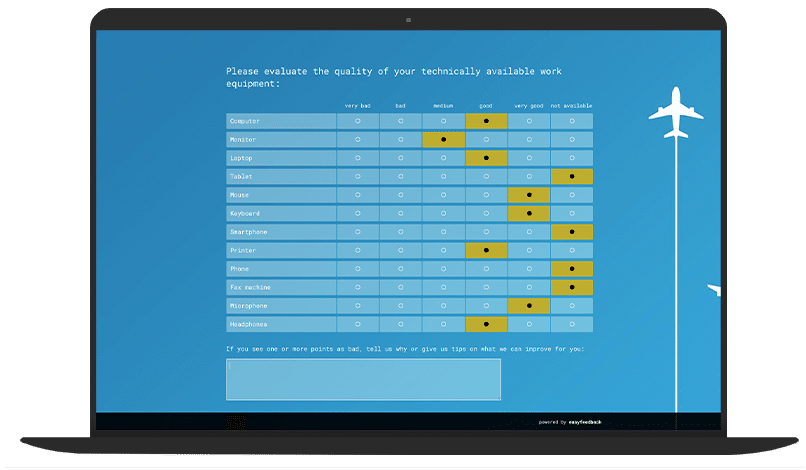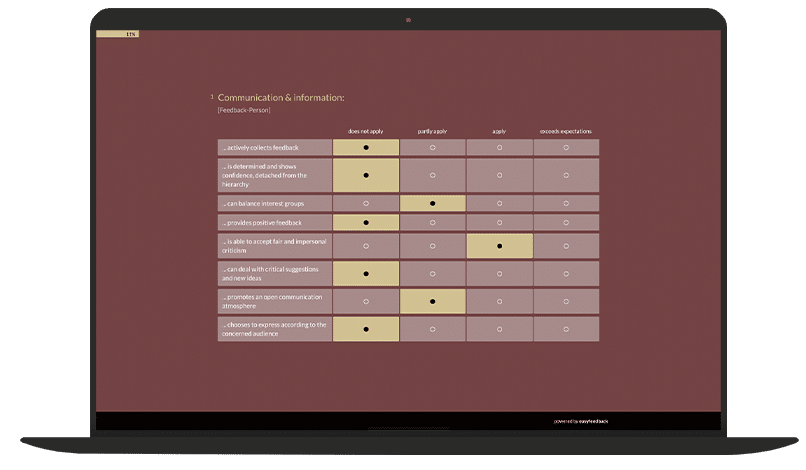Why are employee surveys not well received?
In many companies, there is unfortunately still the prejudice that employees are to be spied out by participating, that negative comments are traced back to the respective employee and that he or she then has to expect negative consequences.
Managers are also often less than enthusiastic about employee surveys, fearing that the survey is merely intended to pillory them.
Another misconception is often that the survey is only conducted pro forma and that suggestions for change will not be implemented anyway.
All these reasons initially lead to a rather skeptical attitude toward the survey from the employees’ point of view.
So now it is a matter of gradually removing the concerns and making room for a new way of thinking.
The employee must learn that the survey is not to his or her disadvantage, but has a positive effect on him or her, for example by improving working conditions or the working atmosphere.
And that is exactly the point!
If he realizes this, he will also be willing to participate in the next survey.
But how do you move away from this negative view toward more openness and trust?

In our experience, communication is one of the most important building blocks for greater acceptance of surveys in companies.
If the exact purpose of the survey is openly communicated in advance and it is pointed out that the survey is anonymous, this is already a good door opener.
Another important aspect is to put yourself in the employee’s shoes and think in advance about how the survey will affect the employee.
Under no circumstances should the survey give rise to the feeling that the employee is being controlled or evaluated.
Rather, it should be clear that his or her honest feedback is intended to optimize processes and improve working conditions.

In small companies that work together in close proximity, for example sharing a large office where people talk to each other a lot and pass on information to each other, it is often the case that there is already a higher level of acceptance of surveys.
It is more difficult in larger companies with several locations or also production companies with outsourced production sites.
Here it can happen that the information is only partially passed on and own interpretations are added.
The division into different groups (production and office or office and field service) can then lead to possible differences.
But even here it is possible to gain the trust of the employees with our Insight.
How can I achieve acceptance of employee surveys?
If your employees are skeptical about surveys, you can start by conducting one or two surveys on innocuous topics.
Here, for example, a survey on the required work equipment is a good idea. In production plants, for example, gloves, a helmet, protective hoods, safety shoes and other equipment must be worn.

This is the work equipment that makes the employee’s work easier or more difficult and should protect him or her as best as possible.
If you now ask your employees how well they get along with their work equipment, whether it is durable or comfortable enough, the employee senses that this is not a judgment of him or her and is more willing to participate in the survey.
If, on the basis of the initial results, action is then quickly taken, for example by providing new work shoes that are more robust or more comfortable to wear.
Then the employee realizes that taking part in the survey has a positive effect on him and will probably be willing to take part in further surveys.
In this way, trust in surveys is built.

The second survey can then be somewhat more intensive, and one or two more critical questions can be included.
For example, questions can be asked about work processes, optimization suggestions or bottlenecks.
By actively involving your employees in shaping the company, they feel listened to and understand that their contribution can help to change something.
But be careful: It is important to use the feedback to initiate changes and follow up with action. Employees’ comments must not simply be left in the air, because otherwise the trust and acceptance of employee surveys will be lost immediately.
When you notice that acceptance for your surveys has increased, you can slowly address more sensitive topics, such as a 360-degree survey for evaluating managers.

Due to the increased trust, you can expect constructive feedback from the respondents here as well. And it will also allay executives’ fears that they will be pilloried as scapegoats.
It is not a matter of finding someone to blame, but of using constructive feedback to facilitate corporate development.
And this involves the holistic development not only of employees, but also of management in particular. Because rethinking starts at the top.
That was today’s insight from Dennis on how you can increase the acceptance of surveys among your employees.
We hope you enjoyed the insight and that it will help you to reduce fears and prejudices through more openness and transparency on the topic of feedback and to build a healthy feedback culture in your company.
We wish you every success in trying it out.



